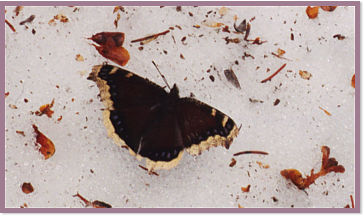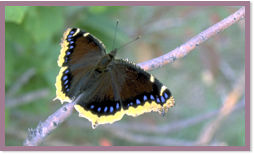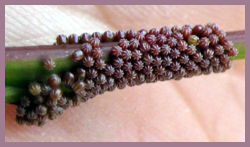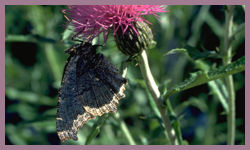
Mourning Cloaks - Butterflies in the Snow!
By Doug Collicutt
 A Mourning Cloak on snow in March.
A Mourning Cloak on snow in March.It's late March. The sun is shining, there's a gentle south wind. Meltwater is running quickly down the lane and dripping off the roof. It's wonderful to bask in the coming of spring. The first flitting butterfly of the season just adds to the beauty of the day. Wait a minute! A butterfly . . . in March? No, you're not seeing things. What you're probably seeing, flying over the last snow banks of winter, is a specimen of one of Manitoba's most common butterflies, the Morning Cloak (Nymphalis antiopa).
The Mourning Cloak is one of a number of Manitoba butterfly species that overwinter as adults. They spend the winter frozen in "cryo-preservation" (See Frozen Alive in our Winter Issue) in tree cavities, beneath loose tree bark or in unheated buildings. Virtually anywhere they can fit into, to protect them from winter winds and keep them out of the view of birds and squirrels, will do as a hibernaculum (an overwintering den).
|
Name Derivation
The North American common name for this species, Mourning Cloak, refers to its resemblance to a traditional cloak worn when one was "in mourning". Its common name in England is "Camberwell Beauty". Doubtless, it has many other common names throughout its Eurasian range.
Scientific Name:
Nymphalis - of, or pertaining to a fountain (Latin)
antiopa - wife of Lycus, King of Thebes (Greek)
And your guess is as good as mine, as to how it got such a name! Yes, I know, scientific names are supposed to have something to do with the nature of the critter being named. That usually applies to species that have been described and named fairly recently. And that means most North American plants and animals. However, this species of butterfly also occurs in Europe and was probably named in an earlier, more "romantic" era. We'll keep checking to see if we can find out why the Mourning Cloak came to be named Nymphalis antiopa. Anybody out there know?
Family: Nymphalidae (brush-footed butterflies)
Mourning cloaks belong to one of the larger families of butterflies, the Nymphalidae. You may notice on some of our pictures of Mourning Cloaks that they seem to have only 4 legs, contrary to the general rule of 6 legs for insects. Members of the Nymphalidae are more commonly known as the "brush-footed butterflies". The front pair of legs are greatly reduced in these insects, often appearing as hairy and "brushlike", hence the name. Why this condition has evolved is, like so many things in nature, uncertain.
Description
Mourning Cloaks are a fairly large butterfly with a wing span of 6-10 cm. The dark, brown wings with beige coloured edges and blue spots make them easy to identify. The underside of the wings are cryptically coloured, dark brown with lighter brown edges.
Distribution
The Mourning Cloak is found throughout most of North America and Europe and in a broad band across central Asia. In Manitoba, it has been recorded throughout the entire province. It is one of our most common and widespread butterflies.
Life Cycle
Adult Mourning Cloak butterflies emerge from their winter hibernation and seek each other out for mating in the spring. In forested habitats, males will perch in sunny glades and wait for females to flutter by. After a brief aerial courtship the pair will mate. The females lay bunches of eggs (30-50?) together on a single tree or shrub, in a mass that surrounds a twig. The butterflies probably die soon after mating and egg laying, having spent as much as 10 months as adults, a long life for a butterfly.
There appears to be some uncertainty as to the number of generations of Mourning Cloaks that occur each year in Manitoba. Some authors suggest that there is only one generation per year, with adults emerging and breeding in spring, and new adults resulting by July. These then aestivate (Aestivation is the summer equivalent of hibernation, employed by many species to avoid the heat and lack of moisture.) until fall, re-emerge, feed and prepare for winter, to awaken in the spring to breed. Others suggest that there may be two generations per year. In this case, overwintering adults breed in the spring, then their resulting offspring breed again in July, resulting in a new batch of adults that emerge from chrysalises in August. These then prepare for overwintering. It seems likely that both scenarios may be played out in Manitoba, depending on the weather of a particular year. Early springs may result in two broods of adults, late springs may result in only one. Anybody out there know for sure? Please let the rest of us know!
(A great link for images of the entire life cycle of Mourning Cloaks.)
Whatever the case may be, the caterpillars emerge from eggs after about 10 days and they will remain together on the same plant. As with all caterpillars, they eat voraciously and grow rapidly. They pass through 5 larval stages, called "instars", by shedding their skins 4 times as caterpillars. The caterpillars seldom move far from being in contact with one of their siblings. If disturbed on a branch, the mass of caterpillars will shake and vibrate in unison, thus, presumably, startling or frightening a potential predator. The bristling spines covering the caterpillars are another good deterrent to predators.

If the group's voracious appetite should happen to exceed the leaf capacity of the small tree or shrub on which they're feasting, they will march off together in a follow-the-leader fashion and seek greener pastures. By mid-June the caterpillars can be full grown. Because of the variability of the onset of spring in Manitoba, the dates when the first batch of caterpillars will mature varies a lot.
When they've reached full size the caterpillars go "walkies"; that is, they leave the host plant where they've been feeding in search of a site to pupate. Like most caterpillars, they seek to distance themselves from the site where they were last feeding and pooping, as this evidence will be apparent to potential predators. "Don't pupate where you last pooped", seems to be the rule! They may travel some distance, 10-50 m, to find a safe site, usually beneath some kind of overhang, such as larger branches in the wild or under the eaves of buildings in cities.
Once it's found a suitable spot, the caterpillar will spin a small anchor pad of silk, attach it's hind end to the pad, then hang, head down, for about a day. ("Going J" we call it, as it hangs with its head down but curled up like the letter J). Then the caterpillar sheds its skin one last time to enter the pupal stage. The pupa wriggles out of the caterpillar skin and works a small hook-like appendage (the cremaster) into the pad of silk to firmly anchor it in place. In several hours it will have hardened into a spiky grey chrysalis.
|
After about 10-15 days, depending on the temperature (less time, the warmer it is), the butterfly will emerge from the chrysalis. It hangs upside down for an hour or two while its wings inflate and dry. Then it flies off in search of food and a mate to start the cycle over.
Habitat
Mourning cloaks are found just about anywhere that their main larval food species are found. They don't seem to be linked to any particular habitat type. But their larval host plants are all trees or shrubs, so these must be available in order for the butterflies to exist in a given area.
Food
The caterpillars of Mourning Cloaks eat the leaves of a wide array of trees and shrubs. Some of their more common host plants include: assorted willows (Salix spp.),aspens and cottonwoods (Populus spp.), elms (Ulmus spp.), and paper birch (Betula papyrifera). Willows seem, to me, to be their favorite food, although in urban areas they really seem to like elms.
The adult butterflies will occasionally come to flowers for nectar, but it's thought that most of their sustenance comes from sap or decaying fruit. Using tree sap as food would explain why Mourning Cloaks can gain some advantage from arising so early from hibernation. When the sap starts to rise in spring it often seeps out of the bark in places where the tree has been damaged over the winter. In summer you'll often find them at fresh holes in trees left by drilling sapsuckers (a kind of woodpecker). Also, like many other butterflies, they will extract salts or other nutrients from mud puddles or even from animal droppings (poops).
Basking
Butterflies must be warm to fly. They need body temperatures close to ours for proper flight. Once they are flying their flight muscles usually provide enough heat to keep them going. Most butterflies bask, opening their wings and angling their bodies toward the sun, to increase their body temperature prior to flight. Basking is particularly important for butterflies that are active in early spring, like the Mourning Cloak. All of our spring-active butterflies have dark coloured bodies and wings to aid in this solar heating.
Thanks for learning about Mourning Cloaks!
Carry on for Mourning Cloaks in the Classroom!![]()
| NatureNorth depends on your support to produce more great articles. Please make a secure donation through PayPal. Our Google Adsense ads pay our server costs, but that's about it. To learn more follow this link: Support NatureNorth. Thank-you! | |
Return to: Spring Issue | NatureNorth Front page



